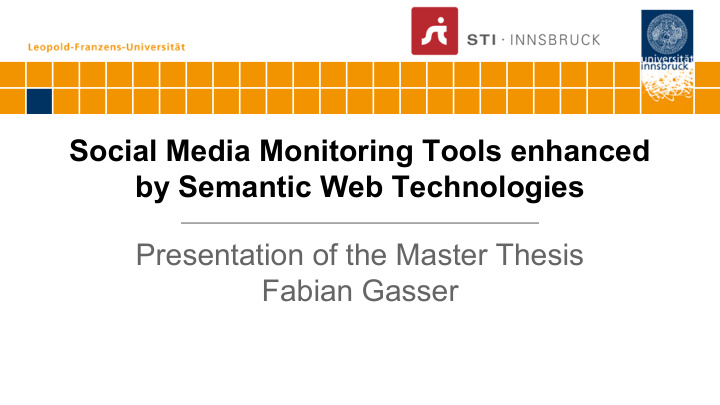



Social Media Monitoring Tools enhanced by Semantic Web Technologies Presentation of the Master Thesis Fabian Gasser
Contents 1. Main Concepts 2. Challenges 3. Research Question 4. Social Media Monitoring Tool Application Landscape 5. Comparison of the Semantic Approach 6. Prototype - Semantic Social Media Monitoring Tool 7. Use Cases 8. Conclusion
Main Concepts: Social Media for Brands Many new challenges through social media (SM) and web 2.0. Most important factors [1]: ○ Confidence ○ Time ○ Amount Companies want to achieve benefits for their business: Source: [2]
Main Concepts: Social Media Monitoring Tools … “enable companies to gather, categorize, analyze, monitor and possibly engage in online conversations about companies, brands, products, competitors, industry and other topics across different social media platforms.” [3, p. 15]
Main Concepts: Semantic Web Technologies ● Semantic web (SW) technologies are intended as “an extension of the World Wide Web that allows computers to intelligently search, combine and process Web content based on the meaning that this content has to humans”. [4, p. 11] ● Ontologies describe an area of concern. ● Resource description framework (RDF) for the description of resources and creation of ontologies via relations(triples): ○ subject - predicate - objects (- context)
Challenges (1/2) Many different Tools and Providers
Challenges (2/2) Possible reasons: ● Different needs from companies and their departments. ● Different tools focus on different abilities. ● Emerging market. Challenges: ● The tool should fit to many different applications. ● The buyers should have high benefits. ● Development and adaptation efforts should not be too extensive.
Research Question (1/2) Research Question: Can SW technologies help to overcome existing challenges and limitations of traditional SMM tools? Proceeding: 1. Elaboration of a SMM tool application landscape. 2. Comparison of the semantic approach with traditional approaches. 3. Development of a semantic SMM tool prototype. 4. Evaluation within two use cases.
Social Media Monitoring Tool Application Landscape main impact of SW technologies
SMM Tool Application Landscape: Social Media Data Gathering Traditional SMM tools: ● Own data sets ⇨ e.g. csv, relational database ● Open source repositories ⇨ e.g. World Bank, Wikipedia ● Data accessible via tools ⇨ free (Google Trends) or commercial (Gnip) ● Data accessible via APIs ⇨ e.g. Social networks, Wikimedia, RSS feeds, blogs Semantic SMM tools: ● Own data sets can be represented in ontologies ● Open source repositories ⇨ RDF dumps from e.g. Wikidata (dbpedia) ● SPARQL-endpoints for querying ⇨ e.g. from participants of the LOD2 project
SMM Tool Application Landscape: Data Preprocessing (1/5) 1. Cleaning data (missing, incorrect, inconsistent data) 2. Structuring and tagging 3. Storage
SMM Tool Application Landscape: Data Preprocessing (2/5) Most important information requirements: ● Categories and topics ● Main phrases and keywords (and connections) ● Sentiments
SMM Tool Application Landscape: Data Preprocessing (3/5) to 2. Structuring and tagging: ➢ in traditional tools [5]: ○ symbolic/linguistic approaches → rule sets ○ statistical/empirical approaches → training data ○ combined approaches
SMM Tool Application Landscape: Data Preprocessing (4/5) ➢ in semantic tools Source: [6]
SMM Tool Application Landscape: Data Preprocessing (5/5) 1. Cleaning data 2. Structuring and tagging 3. Storage: ➢ in traditional tools: flat files, relational databases, NoSQL databases ➢ in semantic tools: focus on triple stores
Comparison of the Semantic SMM Tool Approach Comparison focus on: ● additional abilities ● additional requirements
Prototype - Semantic Social Media Monitoring Tool
Use Cases 1. Tourism domain: ➢ Identification of the needs against a SMM tool. 2. Television producer: ➢ Application of the prototype to one of their social networking channels.
Use Cases: 1. Tourism Domain Main goals on SM: 1. Attract customers outside of the busy seasons. 2. Increase reach and awareness of the hotel (especially in foreign countries, e.g. Russia, France) [8]. 3. Ensure that no claims are overseen. Data source: [7] Findings: 1. Just specific topics are relevant (e.g. skiing or hiking news, claims about rooms and facilities). 2. Multiple languages should be supported. 3. Bad sentiments/claims should be identified together with their topics (e.g. to check their relevance).
Use Cases: 2. Television Producer Data extracted from social networking channel: ● over 500 posts and 1,800 comments Ontologies used in the annotation pipeline: ● DBpedia (remote via DBpedia Spotlight) ● Consumer Electronics Ontology (CEO) 2,118 instances extracted: ● CEO: 603 hits (belonging to 48 different concepts) ● DBpedia: 1,515 hits (belonging to 621 different concepts)
Use Cases: 2. Television Producer (1/2)
Use Cases: Application of a semantic SMM Tools - Evaluation Agenda good results, ++ important good results, not + so important no impact/ 0 not relevant poor results, not - so important poor results, - - important Source of the main application fields of SMM tools: [1]
Conclusion ● Companies want to monitor different information and need different features. ● Adaptations in traditional approaches require the creation of comprehensive rule sets or training corpora. ● Ontologies allow to flexibly adapt the tool and to localize the most interesting topics in different languages. ● More generic disambiguation techniques are needed (e. g. through evaluating the annotations from related posts and comments).
Thank you! Questions?
Sources: [1] Kasper, H., Stuttgart Fraunhofer-Institut für Arbeitswirtschaft und Organisation: Marktstudie Social Media Monitoring Tools: IT-Lösungen zur Beobachtung und Analyse unternehmensstrategisch relevanter Informationen im Internet. Fraunhofer-Verlag (2010) [2] Etlinger, S., Li, C.: A framework for social analytics. Altimeter Group. USA. Published on 10, 2011 (2011) [3] Milic, L.: Social media monitoring tools and services report. Tech. rep., Ideya Business and Marketing Consultancy (2013) [4] Hitzler, P., Krötzsch, M., Rudolph, S.: Foundations of Semantic Web Technologies. Chapman & Hall/CRC (2009) [5] Jackson, P., Moulinier, I.: Natural language processing for online applications: Text retrieval, extraction and categorization, vol. 5. John Benjamins Publishing (2007) [6] Wimalasuriya, D.C., Dou, D.: Ontology-based information extraction: An introduction and a survey of current approaches. Journal of Information Science (2010) [7] Landesinstitut für Statistik ASTAT - Datenbanken - Self Service (2015), http://www.provinz.bz.it/astat/de/service/daten- online.asp [8] Agentur Südtirol Marketing: Mehr internationale gäste und stimmige produktentwicklung für südtirol (2014), http://www. smg.bz.it/de/unternehmen/presse/mehr-internationale-gaeste-und-stimmige-produktentwicklung-fuer-suedtirol
Recommend
More recommend